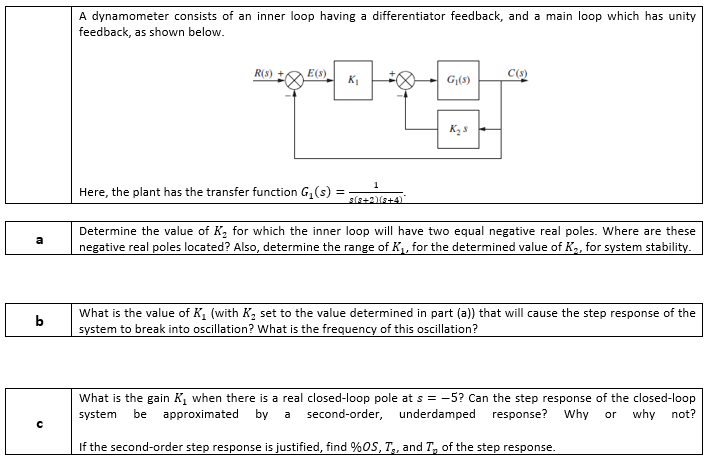A dynamometer consists of an inner loop having a differentiator feedback, and a main loop which has unity feedback, as shown below. R(s) E(s) C(s) K, G(9) Here, the plant has the transfer function G, (s) = ; Determine the value of K, for which the inner loop will have two equal negative real poles. Where are these negative real poles located? Also, determine the range of K,, for the determined value of K,, for system stability. What is the value of K, (with K, set to the value determined in part (a)) that will cause the step response of the system to break into oscillation? What is the frequency of this oscillation?
A dynamometer consists of an inner loop having a differentiator feedback, and a main loop which has unity feedback, as shown below. R(s) E(s) C(s) K, G(9) Here, the plant has the transfer function G, (s) = ; Determine the value of K, for which the inner loop will have two equal negative real poles. Where are these negative real poles located? Also, determine the range of K,, for the determined value of K,, for system stability. What is the value of K, (with K, set to the value determined in part (a)) that will cause the step response of the system to break into oscillation? What is the frequency of this oscillation?
Introductory Circuit Analysis (13th Edition)
13th Edition
ISBN:9780133923605
Author:Robert L. Boylestad
Publisher:Robert L. Boylestad
Chapter1: Introduction
Section: Chapter Questions
Problem 1P: Visit your local library (at school or home) and describe the extent to which it provides literature...
Related questions
Question

Transcribed Image Text:A dynamometer consists of an inner loop having a differentiator feedback, and a main loop which has unity
feedback, as shown below.
R(s)
E(s)
C(s)
K,
G|(8)
K, s
Here, the plant has the transfer function G,(s) = -
s(s+2)(s+4)
Determine the value of K, for which the inner loop will have two equal negative real poles. Where are these
negative real poles located? Also, determine the range of K, for the determined value of K2, for system stability.
a
What is the value of K, (with K, set to the value determined in part (a)) that will cause the step response of the
system to break into oscillation? What is the frequency of this oscillation?
b
What is the gain K, when there is a real closed-loop pole at s = -5? Can the step response of the closed-loop
system be approximated by a second-order, underdamped response?
Why or why not?
If the second-order step response is justified, find %OS, T, and T, of the step response.
Expert Solution
This question has been solved!
Explore an expertly crafted, step-by-step solution for a thorough understanding of key concepts.
This is a popular solution!
Trending now
This is a popular solution!
Step by step
Solved in 5 steps with 2 images

Knowledge Booster
Learn more about
Need a deep-dive on the concept behind this application? Look no further. Learn more about this topic, electrical-engineering and related others by exploring similar questions and additional content below.Recommended textbooks for you

Introductory Circuit Analysis (13th Edition)
Electrical Engineering
ISBN:
9780133923605
Author:
Robert L. Boylestad
Publisher:
PEARSON

Delmar's Standard Textbook Of Electricity
Electrical Engineering
ISBN:
9781337900348
Author:
Stephen L. Herman
Publisher:
Cengage Learning

Programmable Logic Controllers
Electrical Engineering
ISBN:
9780073373843
Author:
Frank D. Petruzella
Publisher:
McGraw-Hill Education

Introductory Circuit Analysis (13th Edition)
Electrical Engineering
ISBN:
9780133923605
Author:
Robert L. Boylestad
Publisher:
PEARSON

Delmar's Standard Textbook Of Electricity
Electrical Engineering
ISBN:
9781337900348
Author:
Stephen L. Herman
Publisher:
Cengage Learning

Programmable Logic Controllers
Electrical Engineering
ISBN:
9780073373843
Author:
Frank D. Petruzella
Publisher:
McGraw-Hill Education

Fundamentals of Electric Circuits
Electrical Engineering
ISBN:
9780078028229
Author:
Charles K Alexander, Matthew Sadiku
Publisher:
McGraw-Hill Education

Electric Circuits. (11th Edition)
Electrical Engineering
ISBN:
9780134746968
Author:
James W. Nilsson, Susan Riedel
Publisher:
PEARSON

Engineering Electromagnetics
Electrical Engineering
ISBN:
9780078028151
Author:
Hayt, William H. (william Hart), Jr, BUCK, John A.
Publisher:
Mcgraw-hill Education,